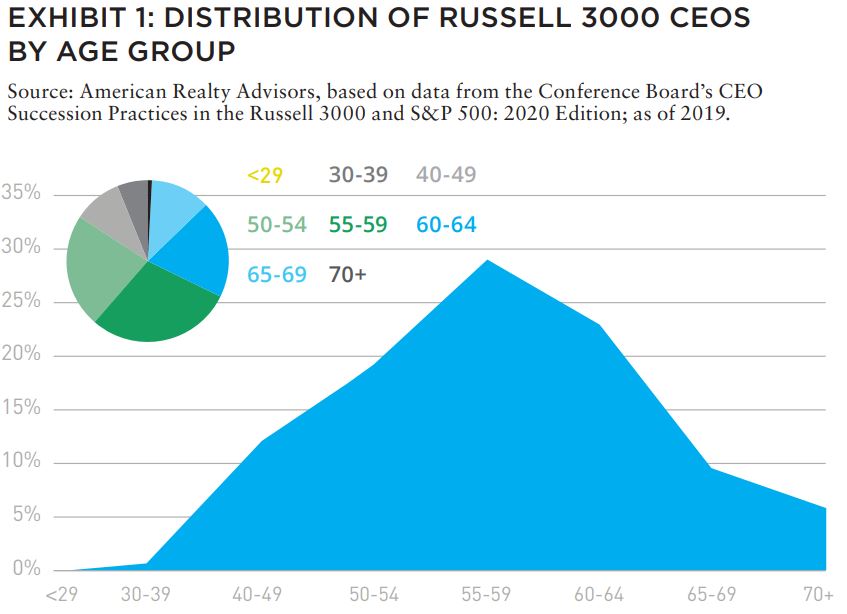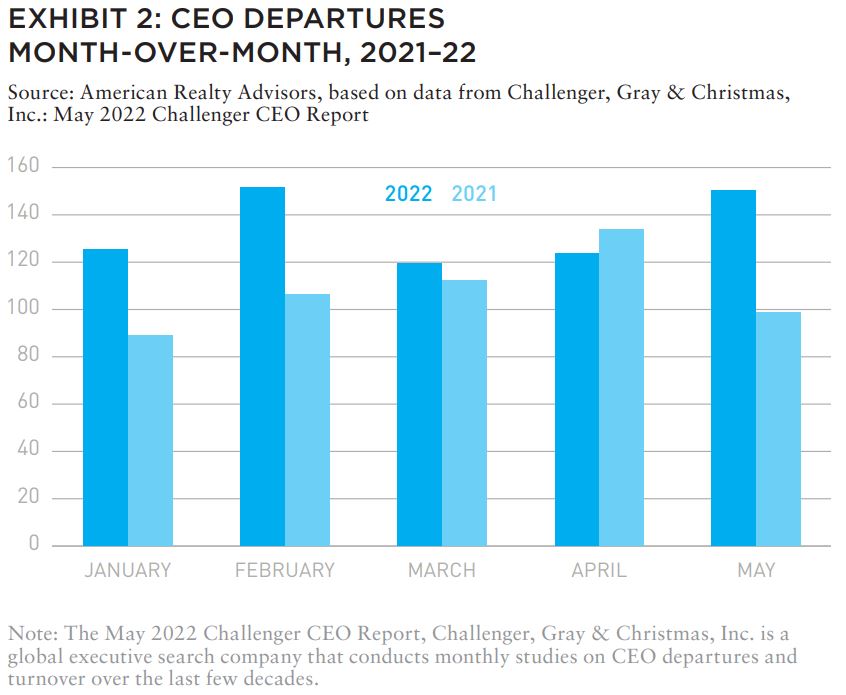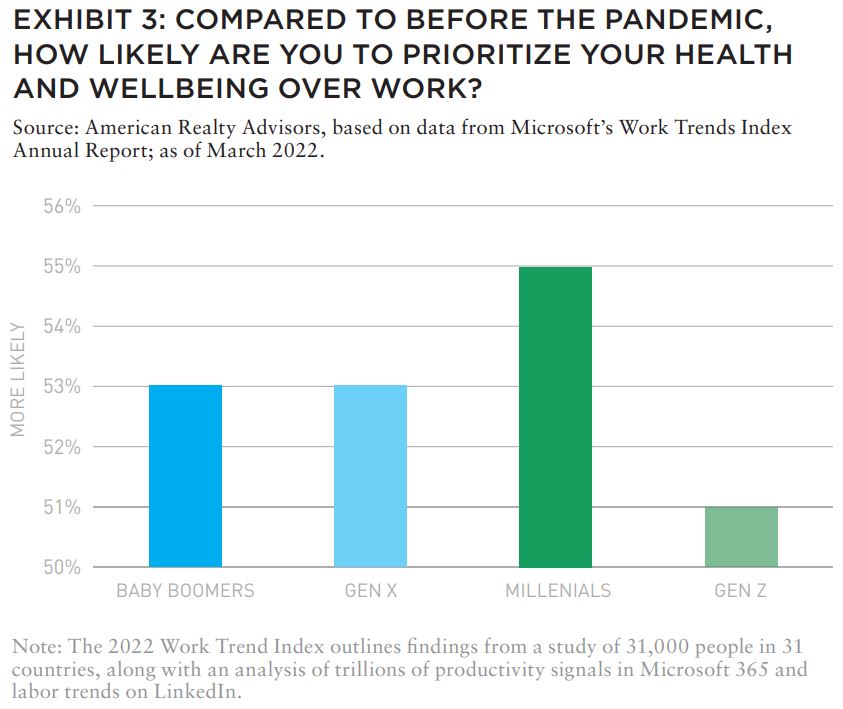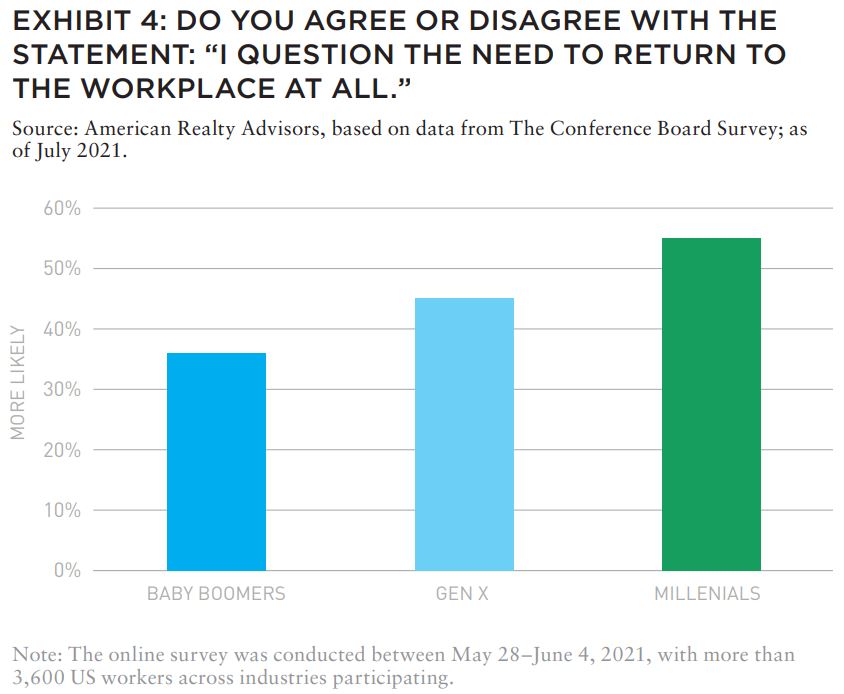Forecasts about the future of the office sector are often wildly conflicting, but the looming high tide of generational leadership transitions could change the script.
The word “office” has become synonymous with uncertainty for real estate investors. For every data point that seems to suggest the end of the modern workplace as we know it, there is an equal number touting the benefits of in-person collaboration, with several major employers taking hard stances about return-to-work expectations. How demand and usage ultimately shake out will have lasting implications for a property type that represents a quarter of ODCE funds’ holdings.1
Beyond these data, there is another transitional force to interpret. Millennials are moving closer to peak corporate influence as they age into their prime C-suite years in the coming decade. The depth of this generational handover, and the difference in values and perspectives between the current and next cohort of leaders (and their Gen Z employees), provides an important clue about longer-term prospects for the office sector.
LEVELING THE FIELD
Two years on since the beginning of the pandemic and the massive work-from-home experiment, the majority of office occupiers have firmed up their post-pandemic return-to-work strategies, with most adopting some level of flexibility, whether begrudgingly or willingly.
The lasting effect of this acceptance on space demand is yet to fully materialize in the fundamentals data, given rolling expirations that will distribute the impact over several years. However, 2022 stands to represent the toughest test for landlords yet, as 11% of leased office space in the US is set to expire.2 How much of the roughly 900 million SF of leased space expiring between now and 2026 will be renewed is still anyone’s guess, though the general consensus is less.
Some have argued that an economic recession could spur a more meaningful return to the office, as looser labor market conditions would shift the leverage more firmly back into employers’ hands, making a forced return to the office more viable. This silver lining has given life to the hope that this period of office demand flux could be relatively short-lived.
To believe a recession will reset the playing field is both overly optimistic and shortsighted. A looming transition in the makeup of corporate leadership by virtue of a generational handoff from Baby Boomer and Gen X managers to Millennials in the next decade stands to prevent the current office approach from backsliding, and may even reinforce it, creating meaningful implications for long-term holders of office properties.
A COMING CHANGE-UP IN THE C-SUITE
As corporations have grown larger and more profitable over time, boards have naturally sought to fill key leadership positions with professionals who have the depth of experience to steer these big ships; the kind of experience that comes with age. This gradual “graying” of the C-suite has created a backdrop where departures are beginning to occur with increasing frequency as the front end of the Baby Boomer generation enters retirement, leaving a sizable gap that next-in-line Gen Xers will be unable to wholly fulfill on their own.
More than half (52%) of sitting CEOs in the Russell 3000 are between 55 and 65 years old; the average age of departure: 61.3 While this statistic suggests an imminent wave of change (given people are living and working longer), it is the tail ends of the distribution that mask the true depth of potential for disruption, as the number of CEOs age 70 or older outnumber those under 40 by a measure of six to one (Exhibit 1).

Lion’s share of Russell 3000 CEOs are between 55-65 years old, though the number of sitting CEOs 70+ outnumbers the number of CEOs under 40 six to one.
Over the last three years, nearly 4,300 companies saw turnover in their CEO position, as boards reimagined goals for their leadership and leaders reevaluated their willingness to serve in a rapidly changing business environment. And this pace is accelerating: through the first five months of 2022, CEO turnover increased 24% year-over-year (Exhibit 2).
Of course, not all turnover is a function of retirement. But of the 668 CEOs that have left through May of 2022, 183 stepped into other high-level roles within the firm, 39 left for new opportunities, and 155 (or 23%) retired. As the crest of the Baby Boomer wave isn’t projected to reach retirement until 2030, the structure of corporate leadership, as well as their approaches to office space, is in the early stages of transformation.
Given the inevitable importance of Millennials in filling vacant C-suite roles, the cohort’s values and struggles may provide insight into how their leadership styles may evolve, and what the corresponding impact may be on the office landscape. Millennials, like most office workers, have become accustomed to the recent work-from-home experience. This enhanced work-life balance has created a fundamental shift in the Millennial worker’s perspective on the way work can and should fit into their daily lives.

Year-to-date CEO turnover through the first five months of 2022 was up 24% year over year.
Recent survey results reflect this dramatic shift in priorities. According to the 2022 Work Trend Index4, 55% of Millennial respondents stated they are now more likely to prioritize their health and wellbeing over work than they were before the pandemic (Exhibit 3). Furthermore, when surveyed as to whether they felt there was a need to return to the office at all, 55% percent of Millennial respondents questioned the need, far outpacing the percentage of Gen X and Baby Boomer respondents who felt similarly (Exhibit 4).5
Millennials are also increasingly conscious of the positive impact work-from-home (WFH) and hybrid working could have on underrepresented groups. Millennials’ early years of employment were marked by the growing focus on corporate diversity, equity and inclusion (DEI) efforts. It is safe to bet that these value pillars will continue to drive Millennial decision-makers and their approach to office-based work.
The shutdown of schools, child, and elder care facilities during the pandemic shined a renewed light on how much progress remains to be made when it comes to gender access and equality. With women spending on average between three to six hours per day on unpaid caregiving work, compared with an average of less than two hours per day for men6, it comes as no surprise that the pandemic displaced 1.7 million more female workers than male.7 WFH allows women to remain productive while balancing domestic responsibilities and provides firms more opportunities to improve the gender labor gap. Minority, immigrant, and ably challenged groups also benefit from flexibility, as WFH may reduce the impacts of microaggressions, prejudice, and the physical demands of commuting, all of which can cause employee burnout and impair well-being.

Through the dual lenses of work-life balance and greater labor equity, Millennials appear poised to add further challenge to the traditional office model when they inevitably step into leadership roles. Yet the desires of the subsequent generation (Gen Z) and the need for Millennial leaders to cater to this cohort, suggest the conclusion is not as clear cut. While the younger generation clearly values WFH flexibility (Gen Z is 77% more likely to engage with a job posting on LinkedIn if it states flexibility in the description), many are only beginning their professional careers and greatly fear they will miss out on pivotal professional development by not being in the office. Additionally, 41% of Gen Z respondents fear that fully remote work will prevent them from building relationships, receiving mentoring, and even being promoted due to possible “out of sight, out of mind” mindsets amongst leadership.8
These are specific generational preferences that will influence the future of office in the coming decade, but there are also more practical elements that come with every new generation entering the workforce that suggest a level of permanence. With many new graduates living with family or roommates, offices provide younger generations with dedicated workspaces that they don’t have at home—spaces less useful or necessary for more senior colleagues.

With many firms currently operating in a hybrid model, this standard appears to best meet current and future employee demands for WFH flexibility and corporate community. Though the pandemic has shown that some work can be done asynchronously, many firms are expected to maintain a central location for collaboration and knowledge sharing. Furthermore, the office fulfills workers’ social needs. This is a critical component to holistic wellbeing that has been proven to increase productivity and morale and reduce employee turnover. When asked to compare their social wellbeing, 50% of fully remote respondents reported feeling lonelier than they had pre-pandemic.9
It is safe to say we are already getting a glimpse into what the future of office will look like under Millennial leadership. Though there has been some reluctance to embrace the current environment as the new stasis, the pandemic’s impact is too great and too ingrained to not have a lasting effect. As worker values have drastically changed over the past two years, it appears there is no going back to the office of the past, especially for younger generations.
The future of office is truly up-for-grabs in the aftermath of the COVID pandemic and the Great Resignation. As this article appropriately notes, the near-term outcome is not indicative of what the future outcome may be upon the transition of leadership from the Boomer generation— which was raised on the importance of being in the office—to Millennials, who may have seen how office presence is a bit overrated.
The fact that fifty years of office work culture was virtually destroyed by six months of working from home emphasizes that being in the office five days per week is not really necessary for getting most jobs done and done well. However, being in the office for some period of time does add value to many roles and many business outcomes. Finding that balance of corporate culture, innovation and personnel flexibility will take more than just saying three out of five days is enough.
How this new thinking about employee presence will impact the use and need for office space is still to be seen. Surely leasing less space will appear to be the simple answer, but it is not guaranteed to be the best answer. Most office users had reduced their space/employee to a mere 125–150 SF per person, which was creating space that was not necessarily best suited for the best outcomes from employees, so getting back to the past levels of 200+ SF per person will utilize more space even with many of the employees not present more than 60% of the time. If corporate leadership is onboard with extensive hybrid or remote work, office space will need to find another use and will change central business districts and corporate culture forever.
The future of the office market in the US, and probably globally, is cloudy—but it isn’t dark. This article is a great way to start the considerations and conversations.
—
ABOUT THE AUTHOR
Sabrina Unger is the Managing Director, Head of Research and Strategy and Britteni Lupe is an Associate, Research & Strategy at American Realty Advisors, one of the largest privately held real estate investment management firms in the US.
—
NOTES
1. “Open End Diversified Core Equity (NFI-ODCE),” NCREIF, updated Q1 2022; ncreif.org/data-products/funds/.
2. “US Office Outlook—Q1 2022,” JLL, updated July 12, 2022; us.jll.com/en/trendsandinsights/research/office-market-statistics-trends, accessed April 2022.
3. “CEO Succession Practices in the Russell 3000 and S&P 500: 2020 Edition,” The Conference Board; conference-board.org/topics/ceo-succession-practices/ceosuccession-practices-2020.
4. “Annual Work Trend Index Report,” Microsoft, updated 2022; microsoft.com/en-us/worklab/work-trend-index.
5. “Survey: Amid Higher Productivity, 43 Percent of US Workers Question Need to Return to Workplace,” The Conference Board, updated July 2021; conference-board.org/press/ Return-to-Work-Survey-June2021.
6. Gaelle Ferrant, Luca Maria Pesando, and Keiko Nowacka, “Unpaid Care Work: The Missing Link in the Analysis of Gender Gaps in Labour Outcomes,” OECD Development Center, updated December 2014; oecd.org/dev/development-gender/Unpaid_care_work.pdf.
7. Tim Henderson, “As Women Return to Jobs, Remote Work Could Lock in Gains,” PEW Charitable Trusts, updated May 3, 2022; pewtrusts.org/en/research-and-analysis/blogs/stateline/2022/05/03/as-women-return-to-jobs-remote-work-could-lock-in-gains.
8. Erica Pandey, “Younger Employees Fear Being Left Behind by Remote Work,” AXIOS, updated July 2021; axios.com/2021/07/13/gen-z-remote-work.
9. “Annual Work Trend Index Report,” Microsoft, updated 2022; microsoft.com/en-us/worklab/work-trend-index.
EXPLORE THE LATEST ISSUE

CAPITAL MARKETS PULSE
Through the rest of this year, investors forecast challenges for global capital, but thoughtful investors are forging ahead.
Gunnar Branson and Benjamin van Loon | AFIRE
ON/OFF SWITCH
While the market rarely sends clear investing signals, current market conditions are replete with clues, but as timing for corrections is difficult, a move to risk-off strategies could be useful.
Joseph L. Pagliari | University of Chicago
MOBILE ZONING
Mobile information technology has upended US land use regulation, and the ramifications of this technological upheaval are finally coming into view.
Robert Seldin | Madison Highland Live Work Lofts
GET SMART
As buildings become increasingly technologized, especially after the pandemic, cyber-attacks can put entire properties at risk and require a firmwide security approach.
Noëlle Brisson and Michael Savoie | CyberReady, LLC
HEDGE TRIMMING
The rapid rise in consumer prices has rekindled the old debate about whether commercial real estate provides a long-term hedge against inflation (hint: look at multifamily).
Gleb Nechayev, CRE | Berkshire Residential Investments
THE NEW SCIENCE
While the real estate industry has long understood the need for data, it still struggles with connecting information to decision making. New strides in data science could change that.
Brian Biggs and Ashton Sein | Grosvenor
BRACE FOR IMPACT
The practice and expectations of investing across all industries is undergoing major upheaval and the key to stability will mean looking beyond profit for profit’s sake.
Michael Cooper and Richard Florida | Dream Unlimited Corporation
TRANSITION PLANS
Forecasts about the future of the office sector are often wildly conflicting, but the looming high tide of generational leadership transitions could change the script.
Sabrina Unger and Britteni Lupe | American Realty Advisors
WHAT DRIVES LOGISTICS?
The logistics sector was the winner of the pandemic recession—but is its rise built to last?
Hugues Braconnier and Dr. Megan Walters | Allianz Real Estate
RENEWED PURPOSE
From retail to office to abandoned factories and warehouses, owners of real estate are rethinking—and reinventing—the future of their investments.
John Thomas and Stacey Krumin | Squire Patton Boggs
DATABASICS
Data centers have become an increasingly institutionalized property class over the past several years, but finding success in the sector depends on talent and expertise.
Max Shepherd, Jannah Babasa, and Isabel Ruiz Halter | Sheffield Haworth
COOPERATIVE INVESTMENT
As insurance costs of residential and commercial spiral out of control, a 1400-year-old tradition is poised to offer long-term, sustainable growth for real estate investments.
Ishmam Ahmed | Georgetown University & AFIRE
DOMESTIC MIGRATION TRENDS
Dive into the report to understand if and how COVID impacted domestic migration patterns on a state, city, and zip code level.
Ethan Chernofsky | Placer.ai
UP FRONT
How does the Consumer Price Index account for the cost of housing?
David Wessel and Sophia Campbell | The Brookings Institution

THIS ISSUE OF SUMMIT JOURNAL IS PROUDLY SUPPORTED BY
Aegon Asset Management is an active global investor that manages and advises on assets of $328 billion* for global pension plans, public funds, insurance companies, banks, wealth managers, family offices, and foundations. Aegon AM’s Real Assets platform focuses on delivering yield-oriented and total return solutions spanning the risk/return spectrum.
With an over 35-year history and $25 billion* in AUM/AUA, the Real Assets business is built on a cycle-tested platform, deep and broad market access, and long-term relationships.
Our real assets debt and equity strategies seek to deliver strong relative value and returns through a research-intensive process. The process encompasses thoughtful top-down research and intelligent bottom-up analysis deployed by an experienced multidisciplined team of over 110 investment professionals.*
Each capability is underpinned by dedicated, in-house support and service teams including applied research, engineering and environmental, valuation, accounting, client service, legal and risk management.
*As of June 30, 2022. The assets under management/advisement described herein incorporates the entities within Aegon Asset Management brand as well as the following affiliates: Aegon Asset Management Holding B.V., Aegon Asset Management Spain, and joint-venture participations in Aegon Industrial Fund Management Co. LTD, La Banque Postale Asset Management SA, and Pelargos Capital BV.




